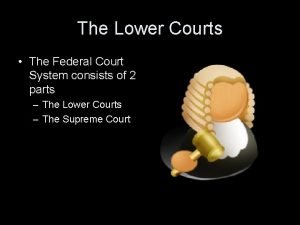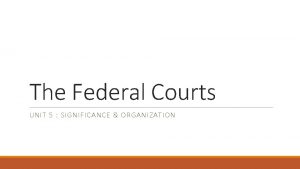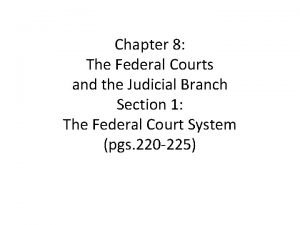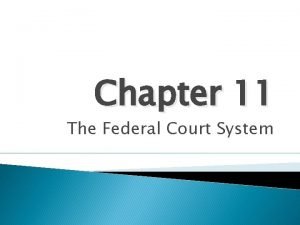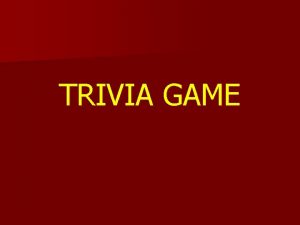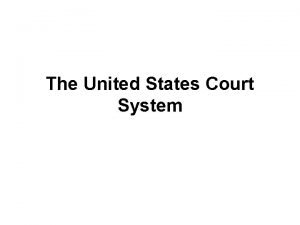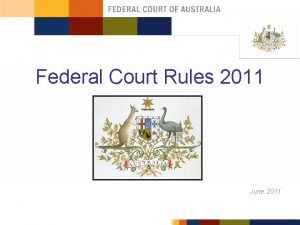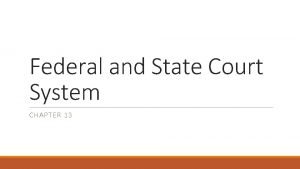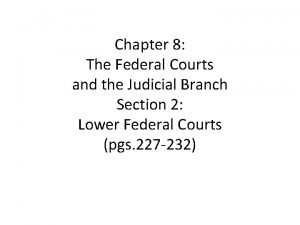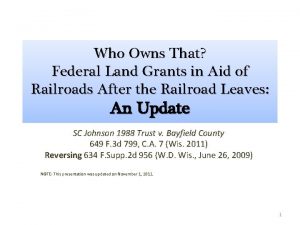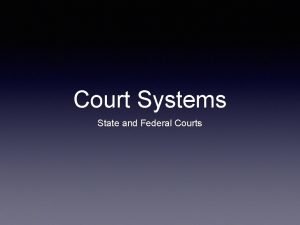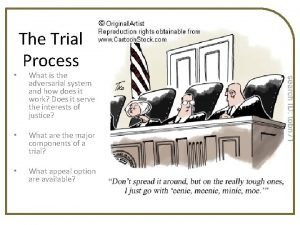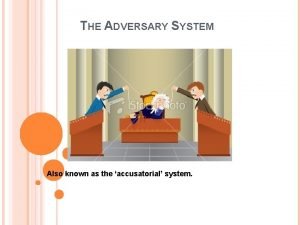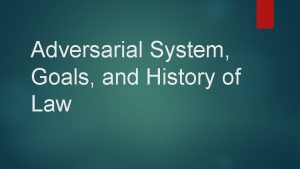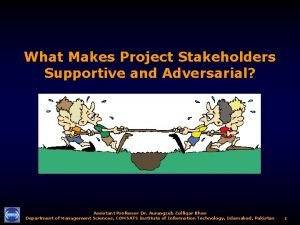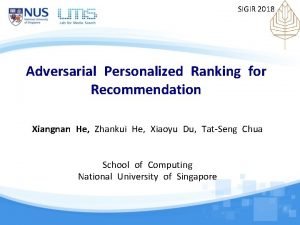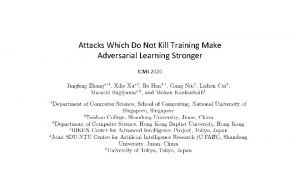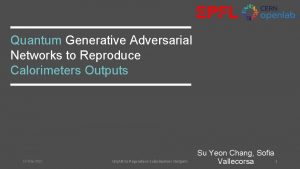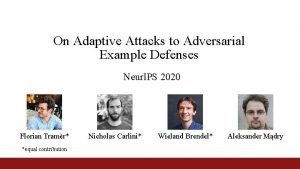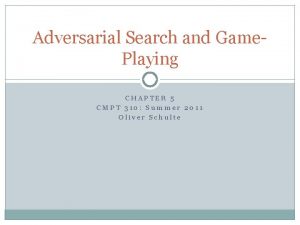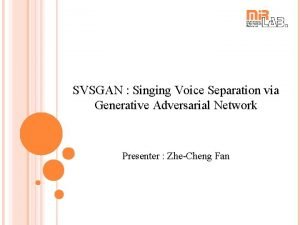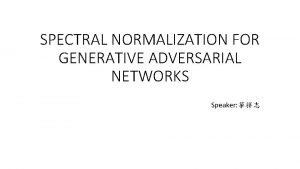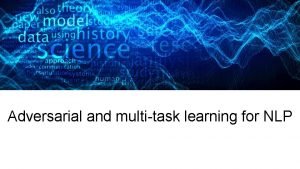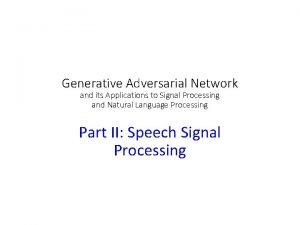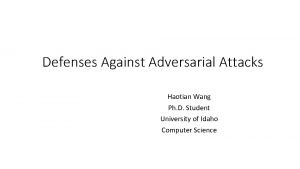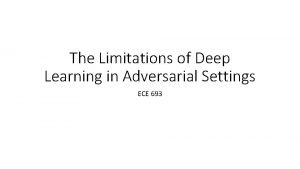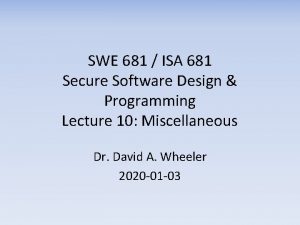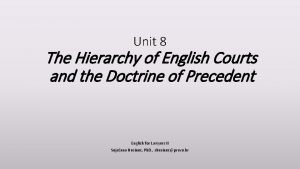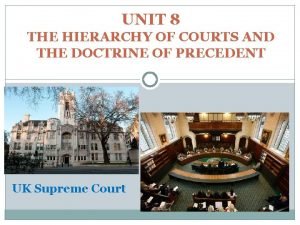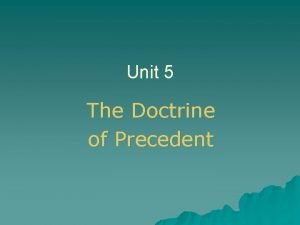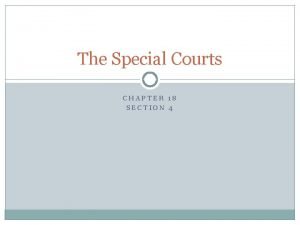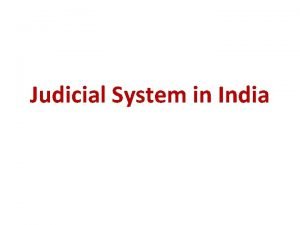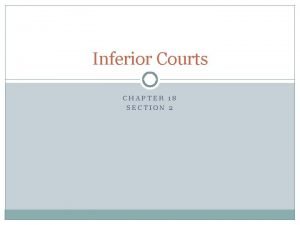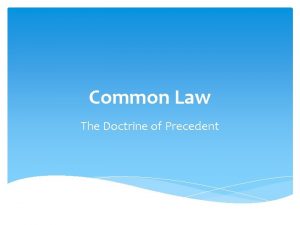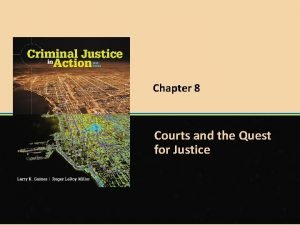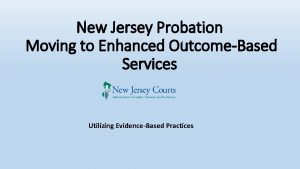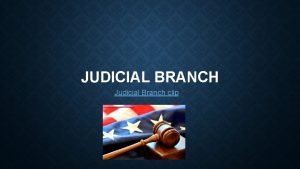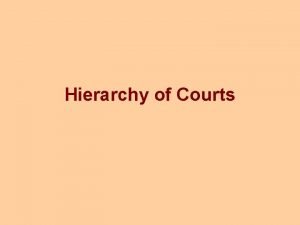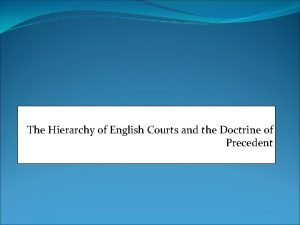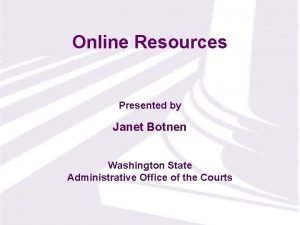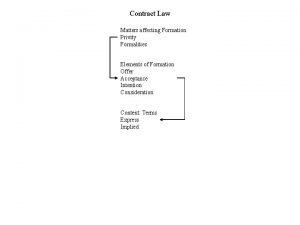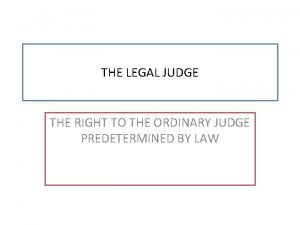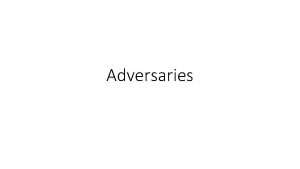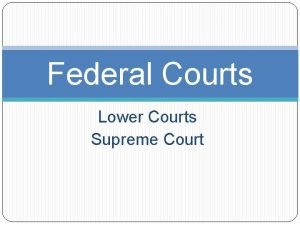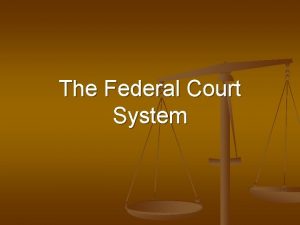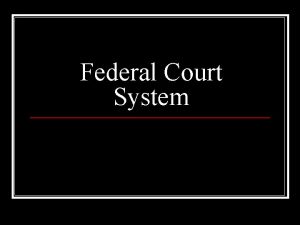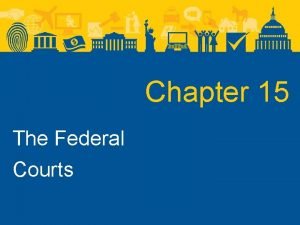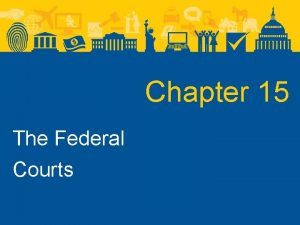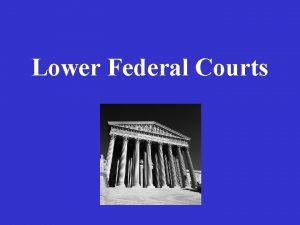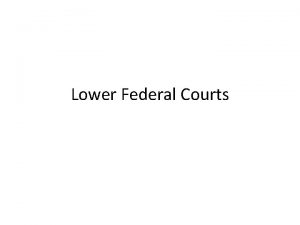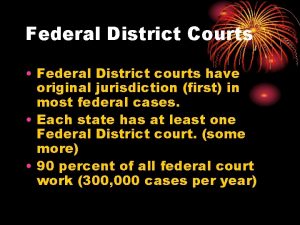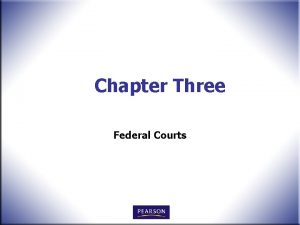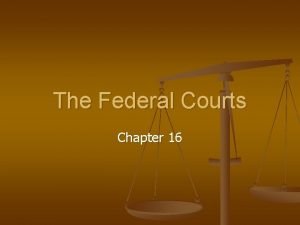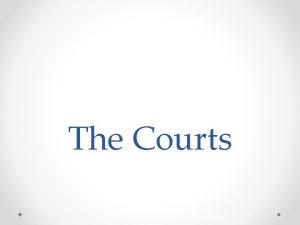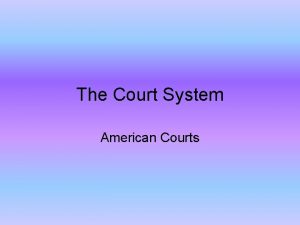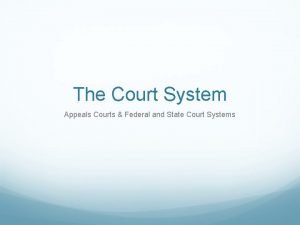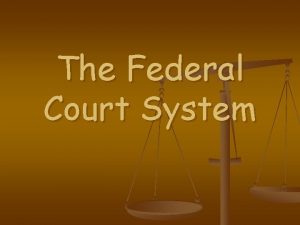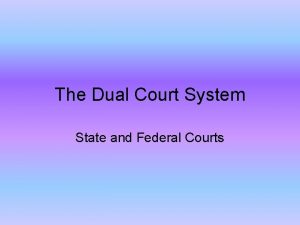THE FEDERAL COURT SYSTEM The Adversarial System Courts


















































- Slides: 50

THE FEDERAL COURT SYSTEM

The Adversarial System • Courts settle civil disputes between private parties, a private party and the government, or the United States and a state or local government. • Each side presents its position. The court applies the law and decides in favor of one or the other.

Duality • There are two separate systems of courts • Federal and State • Article III notes that the Supreme Court is the superior court • Idea of federal supremacy • This is an example of a Constitutional court • Can you guess why? • Special courts have been created by Congress for a special purpose • Armed forces court • Foreign Intelligence Surveillance Court (FISA Court)

The Federal Courts • Jurisdiction • The authority of a court to hear and decide a case • Article III says that the court can hear a case based on subject matter or the parties involved • Subject matter • Interpretation and application of a provision of the Constitution or in any federal statue or treaty • Questions of admiralty or maritime law • Parties • US officers or agencies • Ambassador, consul, or other representative of a foreign government • A state suing another state, citizen of another state, or a foreign government • A citizen of one state suing a citizen of another state • An American citizen suing a foreign citizen or sovereign • A citizen of one state suing a citizen of another state where land claims over multiple states are involved


Exclusive and Concurrent Jurisdiction • Exclusive jurisdiction means that the federal courts have the exclusive rights to hear a case • Ambassadors or foreign government official • Federal crimes • Patent or copyright infringement • Concurrent jurisdiction means that the court shares power with other federal and state courts • Any case that comes from a State Supreme Court

Original and Appellate Jurisdiction • Original jurisdiction is where the case came from • Appellate jurisdiction means that it hears an appeal from a lower court

So. . . when do I start? • Judges at the federal level are chosen by the President • They are then questioned by the Senate Judiciary Committee • Think of it as a job interview • The Senate Judiciary Committee then votes on whether the nominee should be confirmed • The Senate then debates the confirmation and then they vote to confirm with a “up or down vote” (i. e. simple majority)

Sonia Sotomayor taking the oath before testimony at the Senate hearings

What are the qualifications? • Well. . . you see. . . that’s kind of interesting. . . umm. . . cause there are none • No, really, look it up. . . there are none to be found • Then, who ought to be chosen • Depending on the level of judge, experience should count for something • Harriet Myers as a nominee for Supreme Court Justice • Free of political bias • No. . . I’m serious. . . They should be • President George W. Bush said he would choose justices who believed in his political beliefs on certain issues. • A controversial. . . yet absolutely honest answer

Terms • All federal judges are appointed for a life term • Federal judges must be impeached to be removed from office • Grounds for impeachment. . . • Article II Section 4 • "the President, Vice President, and all civil officers of the United States shall be removed from office on impeachment for, and conviction of, treason, bribery, or other high crimes and misdemeanors. “ • High crime and misdemeanors? • Fourteen federal judges have been impeached

District Courts • Eighty percent of the federal case load is handled here • There are 92 district courts in the US • Every district has at least two judges • Usually one judge hears a case • In some special circumstances (like important rights cases) a three judge panel will be assigned by the Congress • Grand juries indict and petit juries try cases • Most of the decisions here are final, but some cases are appealed to a higher level • These courts have original jurisdiction

Think of them as Zuul • Appeals courts are like gate keepers for the Supreme Court • There are 13 Courts of Appeals in the US • We are in the 7 th District Court of Appeals • There are three judges on each panel of the Courts of Appeals • These courts only have appellate jurisdiction • These decisions are final • Unless they are appealed to the Supreme Court


THE SUPREME COURT JUSTICES

Chief Justice John Roberts

Associate Justice Sonia Sotomayor

Associate Justice Samuel Alito

Associate Justice Ruth Bader Ginsburg

Associate Justice Stephen Breyer

Associate Justice Antonin Scalia

Associate Justice Clarence Thomas

Associate Justice Anthony Kennedy

Associate Justice Elena Kagan

The Supreme Court • It is the ONLY court actually created by the Constitution • The court has judicial review • The power of the federal courts to overturn or limit the enforcement of Federal or state laws or regulations that the judges determine have violated the Federal constitution. • The term also covers the power of the Federal courts to overturn or limit the enforcement of state laws or regulations that the judges determine are in direct conflict with Federal laws or regulations regarding a specific subject matter where the Federal constitution gives primary jurisdiction to the Federal government.

Stare Decisis • “let the decision stand” • The Supreme Court prefers to, but doesn’t have to, follow its own prior decisions (“precedents”) • Note: the lower courts MUST follow the decisions of courts above them in the hierarchy

Marbury v. Madison

• In 1800, Thomas Jefferson, a Democratic-Republican (no, that’s not a typo) won the election for the Presidency defeating President John Adams, who was a Federalist • John Adams decided to make appointments of persons who were Federalists to government positions before he left office • On March 3, 1801, the day before he was to leave office, he appointed William (not Stephon) Marbury as a justice-of-thepeace for DC. • He also appointed other positions as well • The next day, Jefferson becomes President • Jefferson finds out about this and refuses to allow the appointments to go through • He tells his Secretary of State at the time, James Madison, not to deliver the appointments. . . literally • Marbury finds out and sues Madison • Uses a writ of mandamus • A court order compelling an officer to perform an act which the officer has a clear legal duty to perform

. . . Continued • Marbury’s claim is that Madison is violating the Judiciary Act of 1789 • This act created the federal court system as we know it • It also gives the Supreme Court original jurisdiction • In an unanimous decision, the court does 2 things • Refuses to hear the case • Rules in such a way to make the section of the Act that talks about the Supreme Court being subject to writs of mandamus unconstitutional

John Marshall’s famous opinion • With every Supreme Court case, questions are asked to the justices • The questions for this case are • Did Marbury have a right to the commission? • Do the laws of the country give Marbury a legal remedy? • Is asking the Supreme Court for a writ of mandamus the correct legal remedy? • The first two are easily answered: yes and yes • The third question, and the history of the court as we know it, is not so easy

. . . Continued • Marshall says in his decision • “It is emphatically the province and duty of the Judicial Department [the judicial branch] to say what the law is. Those who apply the rule to particular cases must, of necessity, expound and interpret that rule. If two laws conflict with each other, the Courts must decide on the operation of each. ” • In denying Marbury’s request, the Court held that it lacked jurisdiction because Section 13 of the Judiciary Act passed by Congress in 1789, which authorized the Court to issue such a writ, was unconstitutional and thus invalid. • Essentially, the 13 th provision was unconstitutional because Congress had changed the type of jurisdiction the Supreme Court had in a specific way • The constitution, in Article III, Section 2 already granted jurisdiction

The impact of Marbury v. Madison • The constitution is the Supreme Law of the Land • All actions are subordinate • Judges, when they swear their oath, may refuse to enforce any action if it conflicts with the Constitution • REMEMBER • This power that the Court has is ARTIFICIALLY CREATED BASED ON AN INTERPRETATION

• In the Court's opinion, Chief Justice John Marshall set forth three principles of judicial review: • The Constitution is the supreme law of the land. • If a law conflicts with the Constitution, the Constitution rules. • The judicial branch has a duty to uphold the Constitution. Thus, it must be able to determine when a law conflicts with the Constitution and nullify that law. • Through its rulings, the Supreme Court interprets the meaning of laws, helping the police and other courts apply them.

Jurisdiction for the Supreme Court • In most cases, it is based on appeals • EXCEPT • Controversies between two or more states • Cases brought against ambassadors or other public ministers

Certs with Retsyn® • The Supreme Court receives about 8, 000 cases • They might hear a tenth of those • Petitions for certiorari • Lower court sends up records to the Supreme Court • Only a few are granted • If this is the case, it is said to have been granted “cert” • Usually appeals go to the court by the party who loses • They have to write a brief to ask the court to hear the case • The opposition writes a brief on why not to hear the case • 4 of 9 to hear the case

This ments taste funny • Oral arguments • Each side has thirty minutes to present their arguments in front of the judge • The justices will ask questions throughout the oral arguments • Once the arguments are finished, the justices decide the case in a separate room • Half of the decisions are unanimous

I respectfully disagree • If the justices decide to write opinions justices who agree with the majority are in the majority opinion • Any justice can write their very own opinion. If they decide to write their own on one side or another, they write a concurring opinion • If they are in the minority of a decision, they can write a dissenting opinion • In all cases where the government is involved the chief lawyer in the case is the Solicitor General

U. S. Solicitor General Donald Verrilli, Jr.

IMPORTANT CASES

Griswold v. Connecticut. . . The most important case you’ve never heard of.

Griswold v. Connecticut (1965) • At issue was an 1879 Connecticut law prohibiting the aiding, abetting, counseling or use of birth control, even by married couples. • The Director of Planned Parenthood, Estelle Griswold who was also a physician, opened a clinic to purposely challenge the law. She was arrested, tried, and convicted of violating the law.

Griswold v. Connecticut (1965) Justice William O. Douglas for the 7 -2 Majority • Douglas began by listing individual rights that were recognized by courts but that were not specifically listed in the Constitution. • “The foregoing cases suggest that specific guarantees in the Bill of Rights have penumbras, formed by emanations from those guarantees that help give them life and substance. Various guarantees create zones of privacy. ” • “The present case, then, concerns a relationship lying within the zone of privacy created by several fundamental constitutional guarantees. ” • “Would we allow the police to search the sacred precincts of marital bedrooms for telltale signs of the use of contraceptives? The very idea is repulsive to the notions of privacy surrounding the marriage relationship. ”

Griswold v. Connecticut (1965) The Other Justices Weigh In • Justice Arthur Goldberg, Chief Justice Earl Warren, and Justice William Brennan concurred and explained that the concept of liberty includes the marital right of privacy. They also cited the 9 th Amendment, which they argued showed that the framers believed there were additional fundamental rights existing alongside those specifically listed in the Bill of Rights. • Justice John Marshall Harlan II concurred and explained that the 14 th Amendment’s due process clause was the proper grounding for the issue. Justice White also wrote a separate concurring opinion also relying on the due process clause of the 14 th Amendment. • Justices Hugo Black and Potter Stewart dissented and charged the majority of inventing a general right to privacy that encompasses whatever they choose to say it includes. • In his separate dissent, Justice Stewart noted that “this is an uncommonly silly law” but one which is not prohibited by the Constitution. • Griswold articulated a right to privacy, but how broad was this right? Certainly it protected “notions of privacy surrounding the marriage relationship” but what else? The next case helped answer that question. Arthur Goldberg Hugo Black

Tests (not of the Emergency Broadcast System) • These are used by the Supreme Court to determine if a certain governmental action is legitimate • United States v. Carolene Products Co • In Footnote #4 law clerk Louis Lusky changed the history of the court forever. • Lusky argues that when the court looks at deciding certain rights (or restrictions of rights) the court may use a higher level of scrutiny to determine if a government action is legitimate

Footnote 4 • There may be narrower scope for operation of the presumption of constitutionality when legislation appears on its face to be within a specific prohibition of the Constitution, such as those of the first ten amendments, which are deemed equally specific when held to be embraced within the Fourteenth… • It is unnecessary to consider now whether legislation which restricts those political processes which can ordinarily be expected to bring about repeal of undesirable legislation, is to be subjected to more exacting judicial scrutiny under the general prohibitions of the Fourteenth Amendment than are most other types of legislation. • Nor need we inquire whether similar considerations enter into the review of statutes directed at particular religious … or national … or racial minorities …: whether prejudice against discrete and insular minorities may be a special condition, which tends seriously to curtail the operation of those political processes ordinarily to be relied upon to protect minorities, and which may call for a correspondingly more searching judicial inquiry

Based in rationale? • Rational basis test • The "rational basis test" mandates that legislation (whether enacted by Congress or state legislatures) which deals with economic regulation must be rationally related to a legitimate state interest. • The level of judicial review for determining the constitutionality of a federal or state statute that does not implicate either a fundamental right or a suspect classification under the Due Process Clause and the Equal Protection Clause of the Constitution. When a court concludes that there is no fundamental liberty interest or suspect classification at stake, the law is presumed to be Constitutional unless it fails the rational basis test • Under the rational basis test, the courts will uphold a law if it is rationally related to a legitimate government purpose. The challenger of the constitutionality of the statute has the burden of proving that there is no conceivable legitimate purpose or that the law is not rationally related to it. This test is the most deferential of the three levels of review in due process or equal protection analysis (the other two levels being intermediate scrutiny and strict scrutiny), and it requires only a minimum level of judicial scrutiny. E. g. , courts use the rational basis test when analyzing the constitutionality of statutes involving age discrimination, disability discrimination, or the Congressional regulation of aliens.

Strictly Speaking • Strict Scrutiny • U. S. courts apply the strict scrutiny standard in two contexts, when a fundamental constitutional right is infringed, particularly those found in the Bill of Rights and those the court has deemed a fundamental right protected by the "liberty" or "due process" clause of the 14 th Amendment, or when a government action applies to a "suspect classification" such as race or, sometimes, national origin.

Three prongs to Strict Scrutiny • It must be justified by a compelling governmental interest. While the Courts have never brightly defined how to determine if an interest is compelling, the concept generally refers to something necessary or crucial, as opposed to something merely preferred. Examples include national security, preserving the lives of multiple individuals, and not violating explicit constitutional protections. • The law or policy must be narrowly tailored to achieve that goal or interest. If the government action encompasses too much (overbroad) or fails to address essential aspects of the compelling interest, then the rule is not considered narrowly tailored. • The law or policy must be the least restrictive means for achieving that interest, that is, there cannot be a less restrictive way to effectively achieve the compelling government interest. The test will be met even if there is another method that is equally the least restrictive. Some legal scholars consider this "least restrictive means" requirement part of being narrowly tailored, though the Court generally evaluates it separately.

Lemon v. Kurtzman • Lemon v. Kurtzman, • Supreme Court of the United States ruled that Pennsylvania's 1968 Nonpublic Elementary and Secondary Education Act, which allowed the state Superintendent of Public Instruction to reimburse nonpublic schools (most of which were Catholic) for the salaries of teachers who taught secular material in these nonpublic schools, secular textbooks and secular instructional materials, violated the Establishment Clause of the First Amendment.

Three pronged Lemon Test • The Court's decision in this case established the "Lemon test", which details the requirements for legislation concerning religion. It consists of three prongs: • The government's action must have a secular legislative purpose; • The government's action must not have the primary effect of either advancing or inhibiting religion; • The government's action must not result in an "excessive government entanglement" with religion.
 Federal court system structure
Federal court system structure Federal court system structure
Federal court system structure Federal court system structure
Federal court system structure The federal court system chapter 11 answer key
The federal court system chapter 11 answer key State courts us
State courts us Is there a basketball court above the supreme court
Is there a basketball court above the supreme court Us circuit court map
Us circuit court map Federal court rules 2011
Federal court rules 2011 Lower court
Lower court Federal district court map new york
Federal district court map new york Federal court structure
Federal court structure Federal and state court systems
Federal and state court systems Adversarial trial system
Adversarial trial system Adversary system meaning
Adversary system meaning Adversarial system law definition
Adversarial system law definition Adversarial stakeholders
Adversarial stakeholders Sigir 2018
Sigir 2018 Pgd
Pgd Quantum generative adversarial learning
Quantum generative adversarial learning Neur ips
Neur ips Adversarial interview
Adversarial interview Adversarial search problems uses
Adversarial search problems uses Adversarial examples
Adversarial examples Generative adversarial network
Generative adversarial network Spectral normalization gan
Spectral normalization gan Generative adversarial networks
Generative adversarial networks Adversarial multi-task learning for text classification
Adversarial multi-task learning for text classification Voice conversion
Voice conversion Adversarial training
Adversarial training Certified defenses against adversarial examples
Certified defenses against adversarial examples The limitations of deep learning in adversarial settings.
The limitations of deep learning in adversarial settings. Adversarial patch
Adversarial patch Generative adversarial networks
Generative adversarial networks Hierarchy of courts uk
Hierarchy of courts uk Courts hierarchy
Courts hierarchy Hierarchy of uk courts
Hierarchy of uk courts The special courts
The special courts Squash court wolverhampton
Squash court wolverhampton 3 types of courts in india
3 types of courts in india Chapter 18 section 2 the inferior courts
Chapter 18 section 2 the inferior courts Court hierarchy
Court hierarchy 4 levels of state courts
4 levels of state courts Tteap
Tteap Specialisation court hierarchy
Specialisation court hierarchy New jersey courts
New jersey courts Judicial restraint clipart
Judicial restraint clipart Jurisdiction of supreme court
Jurisdiction of supreme court Hierarchy of english courts
Hierarchy of english courts Inside courts wa
Inside courts wa When will the courts imply terms into a contract
When will the courts imply terms into a contract The indolent judge
The indolent judge
